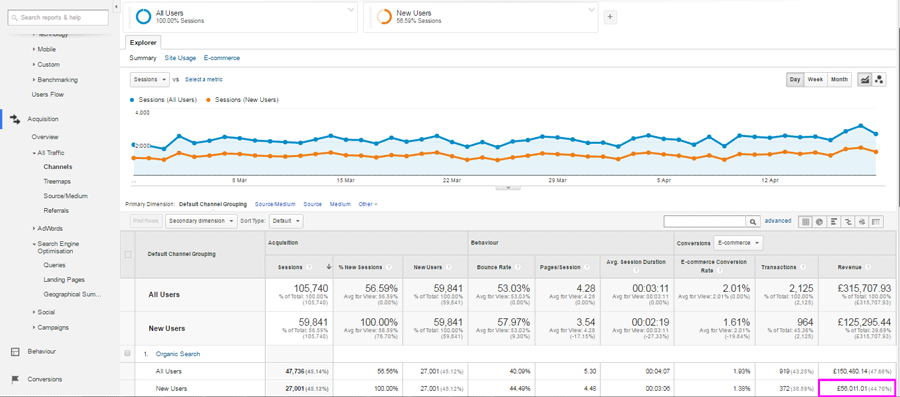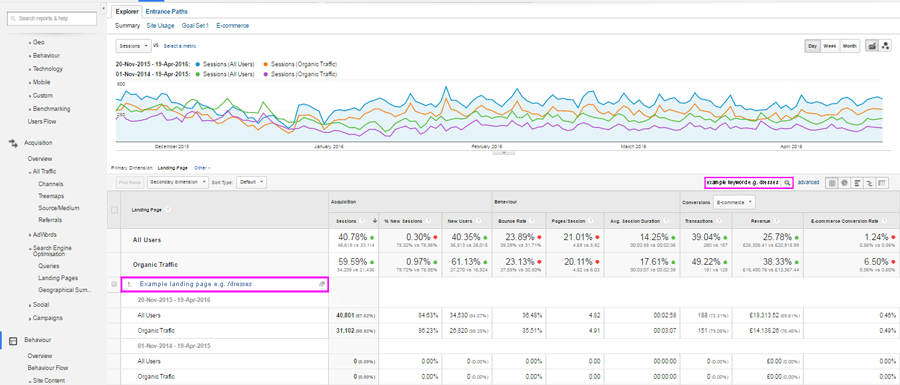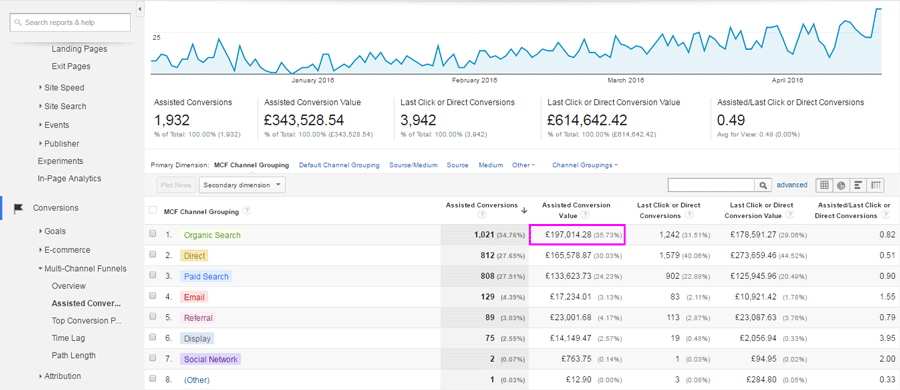6 Sexiest eCommerce SEO Metrics
When you’re working on a site with tens of thousands of pages, how do you showcase your eCommerce SEO prowess and demonstrate the most desirable of all marketing measurements, return on investment?
Life was much simpler when we had the dearly departed organic keyword conversion report in Google Analytics. Now the large majority of keywords are not provided, this post outlines which metrics to use to prove how your beautiful SEO campaigns are increasing online revenue and new online customer acquisition.
Whilst high volume traffic sites still have some indication of which keywords convert in their provided traffic, this data is based on users who are not logged into a Google account and therefore are likely biased towards less web savvy users or those who could even have an aversion to buying online!
Ultimately, running a successful eCommerce SEO campaign can increase sales across all the following traffic types:
- Product level SEO sales e.g. People searching for “Red and white 50s halter neck polka dot dress”
- Category level SEO sales e.g. People searching for “50s day dresses”
- Brand level SEO sales e.g. People searching for “Vivienne Westwood dresses”
- Blog and onsite content SEO sales e.g. People searching for “50s style wedding ideas”
- Direct sales via returning customers originally acquired from SEO and other channels e.g. People typing in your URL directly into their browser
- Direct sales via users using a bookmark or copying the URL from a 3rd party source promoted as part of a SEO or social media campaign (such as a blog or social media post)
- Direct sales via brand new customers using search engines through secure browsing or where the medium information is not sharable with Google. See Google’s definition for direct traffic and the fact that only a proportion is people typing the URL into the browser and this source also includes “Other sources we lump into direct as we don’t know what it is”.
- Referral sales via visitors from 3rd party blogs and Q&A sites promoted as part of a SEO campaign
- Social media sales via visitors from Pinterest, YouTube, Facebook or Twitter where content assets were optimised for relevant keywords as part of a SEO campaign
- PPC sales via remarketing campaigns to previous visitors who originally visited the site from SEO
- Email marketing sales via email campaigns to visitors who subscribed after originally visiting the site from SEO
So measuring the effectiveness of a SEO campaign can get quite complex and you could spend all your SEO resources measuring your results, rather than improving them. So whilst there’s tens of key performance indicators you could measure, here’s our favourite eCommerce SEO KPIs to demonstrate eCommerce SEO performance…
1. eCommerce SEO Revenue
Without doubt, the hottest metric to measure your eCommerce SEO campaigns is comparing eCommerce revenue from SEO – usually compared year on year to take into account changes in seasonal purchasing.

However, like with all metrics this only tells part of the story and year on year decreases could be driven by decreases in average order and/or conversion rate.
Drilling in to the data a bit more and comparing the average order and conversion rate of all eCommerce revenue, plus other channels such as eCommerce PPC, might reveal an overall downward trend that strongly indicates the site is driving less sales across the board. If traffic is also up across the board, then the resulting insight would be to look at the visual merchandising and checkout process as a priority as this would help to reverse this trend and improve overall channel performance.
If eCommerce SEO sales are up and that has been driven by increases in traffic and transactions then that indicates more relevant visitors from search engines are driving those sales. Similarly, if the eCommerce SEO conversion rate increases over time and if this is up in comparison to the conversion rates of other channels, then that demonstrates the eCommerce SEO strategy is driving more relevant buyers to the site than before.
How to get the eCommerce SEO revenue from Google Analytics
- Acquisition
- All Traffic
- Channels
- Organic Search = Revenue
2. eCommerce SEO Transactions
Hot on the heels of eCommerce SEO revenue, measuring eCommerce SEO transactions demonstrates an increase in the number of sales rather than just the amount. This can be particularly useful if you’re looking to attract more new customers than before, as first time buyers are more likely to spend less than existing customers, therefore potentially reducing your average order and conversion rate.

It’s shocking at first, but if you have offline stores or are an established brand that hasn’t invested in much SEO before, your existing eCommerce revenue will likely consist of existing customers who regularly buy from your brand.
So mixing in a load of new SEO visitors that have never heard of you before, into your branded search traffic, will immediately reduce your SEO conversion rate and average order as you’ll have to work harder to persuade the newbies to give your brand a try.
Seeing your eCommerce SEO sales transactions going up should put your mind at ease and lead to investments in complimentary marketing strategies such as 5 star reviews, conversion rate optimisation and email marketing.
How to get the eCommerce SEO transactions from Google Analytics
- Acquisition
- All Traffic
- Channels
- Organic Search = Transactions
3. eCommerce SEO Revenue vs. Total eCommerce Revenue %
When you’re increasing your SEO resources ahead of other marketing spend, you can expect that a greater proportion of your revenue will now be coming from SEO.

A great metric to prove moving budget into SEO has been effective in increasing return on investment is comparing the % of revenue from SEO to the overall revenue over a set time period such as year on year.
If you’re reducing your other marketing spends such as paid media in lieu of increased investment in SEO, then your overall eCommerce revenue won’t likely grow as much as in previous years, if at all. But increasing the proportion of sales now coming from SEO can be clearly demonstrated with this KPI.
How to get the eCommerce SEO revenue % of all revenue from Google Analytics
- Acquisition
- All Traffic
- Channels
- Organic Search = Revenue % (shown in brackets next to the organic search revenue)
4. eCommerce SEO Revenue from New Visitors
Segmenting your eCommerce SEO revenue from new visitors and monitoring over time is another fabulous metric for showing increases in new customers from your SEO campaign.
Comparing eCommerce SEO revenue from new users year on year and month to month is recommended, but breaking down as a % split or by transactions are other alternatives depending on the goals of your campaign and your circumstances.

How to get the eCommerce SEO revenue from new users in Google Analytics
- Acquisition
- All Traffic
- Channels
- Add a new segment, called “New users” (accessed by clicking on “All users” at the top)
- Organic Search = Revenue > New Users
5. eCommerce SEO Revenue from Landing Pages
If you’re looking to see the impact of your offsite content marketing or link building campaigns, then measuring the eCommerce SEO revenue from your landing pages is particularly helpful.

By the very nature of organic SEO, you’re usually limited to the number of high quality links you can generate to different pages of the site month to month. So this metric enables you to hone in on particular eCommerce SEO sales driven from particular pages that have been optimised for their target keywords.
You would need a SEO-friendly URL structure as this metric works by searching for matching keywords in URLs e.g. “Dresses” throughout your dresses category pages.
How to get the eCommerce SEO revenue from landing pages in Google Analytics
- Behaviour
- Site Content
- Landing Pages
- Add a new segment, called “Organic Traffic” (accessed by clicking on “All users” at the top)
- Search for the keyword (use the shortest version to maximise matches e.g. “Dress” instead of “Dresses”)
- Landing Page > Revenue > Organic Traffic
6. Assisted Conversions With eCommerce SEO
A typical multi-channel customer experience involves several touch points before a purchase, so measuring the last-click revenue generated by other channels, where SEO has been part of the mix is essential.
Without including the impact SEO has on channels like PPC, email marketing, social media and vice versa, you can draw the wrong conclusions of how your marketing is performing.
This can be catastrophic if you decide to stop a digital marketing channel because when looking at last-click data only it doesn’t look effective, when in fact that customer wouldn’t have even heard of you without it.

Using assisted conversion data provides additional insight into how your different digital marketing channels play together, and with an integrated approach, their total sum is typically far greater than their individual parts.
For many multi-channel retailers, the SEO assisted conversion value can be around the same value as the last click value, showing that SEO is contributing to often double the revenue than if considering last-click alone.
How to get the eCommerce SEO assisted conversion value in Google Analytics
- Conversions
- Multi-Channel Funnels
- Assisted Conversions
- Organic Search = Assisted Conversion Value
In Summary
Choosing the right eCommerce SEO metrics to suit the circumstances and goals of your campaign will help you to show the value of your organic campaigns. Your metrics will likely change over time and so marking major changes in budget and strategy in your Google Analytics, will help you understand trends across the long term and make the best marketing decisions to achieve your goals.
Follow my contributions to the blog to find out more about eCommerce SEO or sign up to the ThoughtShift Guest List, our monthly email, to keep up-to-date on all our blogposts, guides and events.

